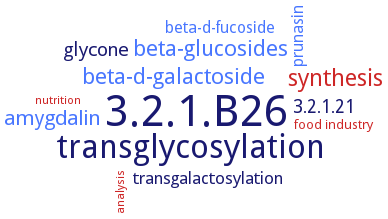3.2.1.B26: Sulfolobus solfataricus beta-glycosidase
This is an abbreviated version!
For detailed information about Sulfolobus solfataricus beta-glycosidase, go to the full flat file.

Word Map on EC 3.2.1.B26 
-
3.2.1.B26
-
transglycosylation
-
synthesis
-
beta-d-galactoside
-
beta-glucosides
-
amygdalin
-
glycone
-
3.2.1.21
-
transgalactosylation
-
prunasin
-
beta-d-fucoside
-
food industry
-
analysis
-
nutrition
- 3.2.1.B26
-
transglycosylation
- synthesis
- beta-d-galactoside
- beta-glucosides
- amygdalin
-
glycone
-
3.2.1.21
-
transgalactosylation
- prunasin
- beta-d-fucoside
- food industry
- analysis
- nutrition
Reaction
Wide substrate specificity, active on aryl-beta-D-galactose, -alpha-L-fucose, -beta-D-glucose and -beta-D-xylose and on di- and oligosaccharides. D-Glucose dimers are hydrolysed in the order of decreasing efficiency: beta-(1,3), beta-(1,4), beta-(1,6). Exo-acting enzyme with a preference for cellotetraose. =
Synonyms
beta-D-glycosidase, beta-glucosidase, beta-Gly, beta-glycosidase, Bgl, bgly, EcSbgly, GH1 beta-glycosidase, LACS, Sbeta-gly, Sbetagly, Ss-beta-Gly, Ssbeta-Glc1, Ssbeta-Gly, SsbetaG, SsbetaGlc1, SsbetaGly, SsGH1, sso1353, SSO3019
ECTree
Advanced search results
General Stability
General Stability on EC 3.2.1.B26 - Sulfolobus solfataricus beta-glycosidase
Please wait a moment until all data is loaded. This message will disappear when all data is loaded.
18.2% of the enzyme is inactivated in the immobilisation process on lyophilised chitosan matrix
-
chaotropes (I-, ClO4-, NO3- and Cs+) have a strong destabilising effect on the protein by perturbing hydrophobic interactions
-
half-life times of the enzyme in hydrolysis of lactose is carried out at 70°C in a continuous stirred-tank reactor coupled to a 10000 Da cross-flow ultrafiltration module (to recycle the enzyme) is approximately 5 to 7 days
-
N-epsilon-methylated beta-glycosidase from Sulfolobus solfataricus is characterized by a higher resistance to aggregation and denaturation at physiological pH, in comparison with the unmethylated form recombinantly expressed
-
the enzyme can be immobilized with little loss of enzyme activity and catalytic efficiency by covalent coupling of the proteins via the surface amino groups to insoluble carriers
-
the stability of the bioreactor at the operative temperatures shows a t1/2 of 30 days at 70°C and a t1/2 of 56 days at 60°C
-


 results (
results ( results (
results ( top
top





